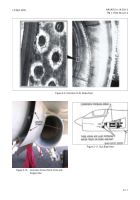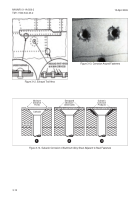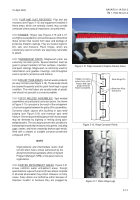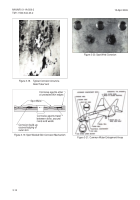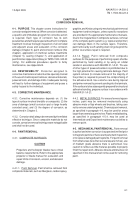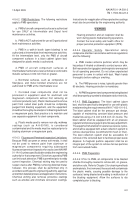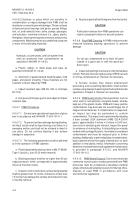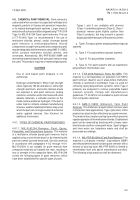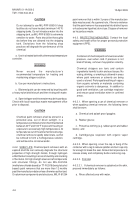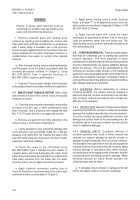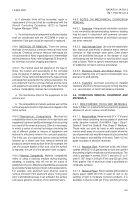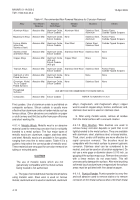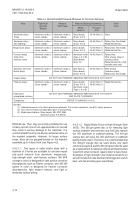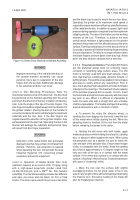TM-1-1500-344-23-2 - Page 80 of 240
4-4
NAVAIR 01-1A-509-2
TM 1-1500-344-23-2
15 April 2009
4-5.4.6.2.Surfaces or areas which are sensitive to
contamination or impact damage from PMB shall be
masked or covered to prevent damage. These surfaces
include precision bearings and gears; grease fittings;
fuel, oil, and hydraulic lines; tanks, pumps, passages,
and actuators; nonmetal surfaces (i.e., glass, plastic,
fiberglass); electrical wiring and connectors; and avionics
components. Masking may be accomplished using one
or more of the following materials:
CAUTION
Hydraulic, oil, pneumatic, and fuel system lines
shall be protected from contamination as
specified in NAVAIR 01-1A-20.
a. Plastic, rubber, or metal plugs and caps, as
specified in NAVAIR 01-1A-20.
b. Aluminum or paper backed masking tapes, kraft
paper, and plastic sheeting. These materials are not
resistant to direct impact by PMB.
c. Impact resistant tape (3M No. 500 or Intertape
BT-100).
d. Hot glue and hot glue gun to seal edges of impact
resistant tape.
4-5.4.7. PMB Procedures.
4-5.4.7.1. Conduct pre-operational inspection of glove
box in accordance with NAVAIR 17-600-191-6-1.
4-5.4.7.2. To prevent surface damage during blasting,
the blast nozzle shall be kept moving at all times in a
sweeping motion and shall not be allowed to dwell in
one place. Do not continue blasting if any surface
damage is suspected.
4-5.4.7.3. The following parameters shall be adhered
to in the operation of PMB cabinets:
a. Plastic bead media shall conform to MIL-P-85891
Type V (acrylic), size 20-30 mesh material.
b. Blasting pressure shall be no higher than 50 psi
output pressure, which corresponds to approximately
40 psi at the blast nozzle.
c. Distance from nozzle tip to surface being blasted
shall be greater than 10 inches. A distance of less than
10 inches may damage the surface and reduce the rate
of coating removal.
d. Nozzle angle shall be 80 degrees from horizontal.
CAUTION
Particulate residues from PMB operations can
lead to catastrophic failure of aircraft systems.
4-5.4.8. Post-PMB Cleaning. All PMB residue must be
removed following blasting operations to prevent
damage.
CAUTION
Do not use compressed air to blow off parts
outside of a glove box or with the glove box
doors open.
a. Inspect all openings to ensure no internal residues
remain. Remove internal residue using a HEPA vacuum
or oil-free compressed air. Reclean as necessary.
b. Surface residue may impact downstream
processing, such as painting operations. Clean surface
residue using detergent washing methods and materials
specified in Chapter 2. Reclean as necessary.
4-5.4.9. PMB Quality Control. Heavy particles, such as
sand, steel or rust particles, and glass beads, shall be
kept out of the plastic media. PMB with heavy particle
contamination may decrease the overall fatigue life of
fatigue critical materials. If contamination is suspected,
an impact test may be performed to confirm
contamination. The impact test is performed by blasting
a bare (unclad) 2024 aluminum (AMS QQ-A-250/4)
panel, approximately 3 inches x 5 inches x 0.040 inch,
once over to simulate paint removal. Inspect the panel
for evidence of nicks/pitting. If nicks/pitting are visually
evident (without magnification), the media is considered
contaminated and must be replaced prior to further
blasting. Additionally, to prevent buildup of contaminants,
blast cabinets will be thoroughly cleaned prior to each
addition of new plastic media. Information concerning
detection of contamination and equipment maintenance
is provided in paragraph 4-5.4.2. and NAVAIR
17-600-191-6-2.
4-5.4.10.
PMB Waste Disposal. Due to toxic materials
commonly found in paint, residue generated from PMB
processes must be considered a hazardous material
unless otherwise directed by local environmental office.
Dispose of used PMB in accordance with local
environmental regulations.
Back to Top


